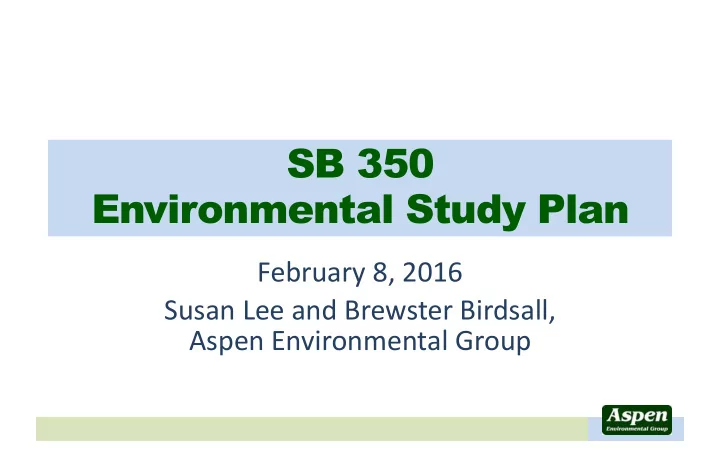

SB 350 Environmental Study Plan February 8, 2016 Susan Lee and Brewster Birdsall, Aspen Environmental Group
SB 350 Study Process • You are here: Ratepayer Impact 2
Agenda • Topics to be covered – Environmental Study Methodology Overview – Scenarios and Modeled Build-Outs – Potential Indicators of Impacts – Initial Screening for Disadvantaged Communities • Key areas for stakeholder input – Appropriate range of topics – Feedback on potential indicators of impacts 3
Methodology Overview • Region of Study – California – Rest of West • Sector Modeling Results – Renewable Energy Solutions (RESOLVE) – Production Cost Simulation 4
Methodology Overview • Three basic steps 1. Describe the regulatory setting and baseline environmental conditions, using GIS tools to focus on sensitive locations 2. Analyze build-out(s) for adverse effects on the environment or a potential to exacerbate an impaired baseline environmental condition 3. Recommend steps to take or indicators that can be monitored to mitigate potential environmental impacts 5
Scenarios and Modeled Build-Outs, Part 1 • Renewable Energy Solutions (RESOLVE): identifies opportunities for infrastructure – Locations identifiable by resource zone – MW capacity and type of new added generation resources and storage – New high-voltage transmission system additions between zones 6
Scenarios and Modeled Build-Outs, Part 2 • Production Cost Simulation: identifies potential changes in system operation of generation – Locations identifiable by unit but will be aggregated – MWh produced and/or displaced by generation or transmission additions – Fuel type(s) used and type of generating unit – Emissions of carbon dioxide (CO 2 ) and key criteria air pollutants 7
Resource Zones Opportunities for infrastructure may be grouped into these Aggregated SuperCREZs from RESOLVE. Results of production cost simulation would also be aggregated. 8
Resource Zones As in California, opportunities for infrastructure across rest of west may be grouped into zones. Some key examples from WREZ Initiative: Arizona West, New Mexico East, Wyoming East, and Oregon South 9
Regulatory Setting • High-level review of – Federal Clean Air Act and state programs – Clean Power Plan (CPP), §111(d) – RPS programs – Land Use (CEQA and other western State Environmental Policy Acts) – Federal Land Management (NEPA) – Endangered Species Act – Federal Clean Water Act and state programs – Cooling Water Intakes, §316(b) – Environmental Justice programs and definition of Disadvantaged Communities 10
Environmental Study Topics • Proposing to focus on six topics and potential changes between sub-regions or resource zones 1. Air Quality 2. Greenhouse Gas Emissions 3. Land Use and Visual Resources 4. Biological Resources and Ecology 5. Water Supply 6. Disadvantaged Communities 11
Potential Indicators of Impacts • 1. Air Quality – Addition of fossil fuel generation capacity – Changing fossil fuel consumption and emissions inside a zone with nonattainment conditions – Shifting fossil fuel MWh production into a zone having more severe nonattainment conditions – Changing MWh production towards coal or natural gas in mapped disadvantaged communities 12
Potential Indicators of Impacts • 2. Greenhouse Gas Emissions – Changing fossil fuel consumption and emissions across entire study region – Changing MWh production towards coal or natural gas across entire study region 13
Potential Indicators of Impacts • 3. Land Use and Visual Resources – Addition of generation or transmission affecting areas designated as sensitive or special use, or areas where development is constrained or precluded – Generation or transmission in or near tribal land areas – Generation or transmission in constrained areas managed as sensitive visual resources (e.g., wilderness, National Parks, scenic highways) – Generation or transmission affecting farm lands 14
Potential Indicators of Impacts • 4. Biological Resources and Ecology – Addition of generation or transmission in locations more likely to be considered sensitive – Potential changes in generation resource mix that would affect local biological resources – Shifting the potential for land disturbance into a zone where likely to affect sensitive biological communities 15
Potential Indicators of Impacts • 5. Water Supply – Addition of thermal generation capacity in a zone of constrained groundwater availability or substantial groundwater depletion – Changing MWh production towards solar and increasing the use of water for construction dust control and ongoing panel washing in a zone of low groundwater availability – Changing MWh production towards technologies that may have greater cooling water demands and cooling water losses 16
Potential Indicators of Impacts • 6. Disadvantaged Communities – Addition of generation or transmission in locations disproportionately burdened by or vulnerable to pollution – Addition of transmission that may negatively alter the physical character and land uses within disadvantaged communities – Potential changes in adverse health effects, to the extent identifiable as a result of changes in emissions – Potential changes in water demand in communities dependent on groundwater for other productive use 17
Disadvantaged Communities • Identify communities, consistent with federal and State policy (SB 535) – In CA, we propose to use CalEnviroScreen 2.0 (the California Communities Environmental Health Screening Tool) • Two types of indicators, without measure of race/ethnicity – Pollution Burden: potential exposures to pollutants and the adverse environmental conditions caused by pollution – Population Characteristics: biological traits, health status, or community characteristics that can result in increased vulnerability to pollution – For Rest of West use U.S. EPA’s EJSCREEN 18
Screening Communities for Pollution Burden • Scores for exposure and environmental effect indicators • Air pollution • Toxic releases • Pesticide use • Traffic density • Drinking water • Groundwater threats • Hazardous waste facilities 19
Screening Communities for Population Characteristics • Scores for sensitive population and socioeconomic factor indicators • Children or elderly • Asthma rates • Low birth weights • Educational attainment • Linguistic isolation • Poverty • Unemployment 20
Overall Result of CalEnviroScreen Combination of Pollution Burden and Population Characteristics Shows the CalEnviroScreen 2.0 score for each census tract; calculated by combining 19 individual indicators. (Source: OEHHA, Nov 2015) 21
Next Steps: Stakeholder Input • Key areas for stakeholder input – Appropriate range of topics – Feedback on potential indicators of impacts • Q&A 22
Recommend
More recommend